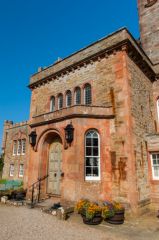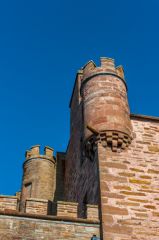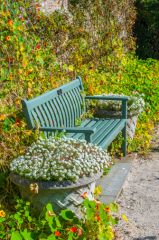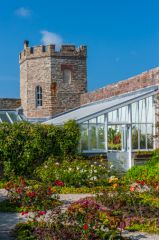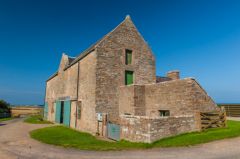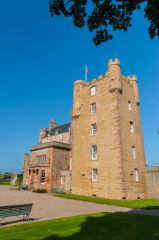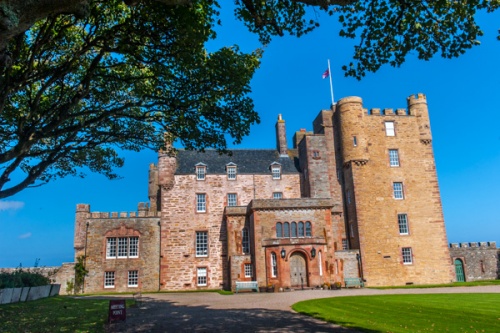
Built by the Earls of Caithness in the mid-1500s, the Castle of Mey is the former home of the late Queen Elizabeth, the Queen Mother. The Queen Mum bought Mey when it was due to be destroyed, and carefully restored it as a place where she could escape from the constant buzz and bustle of public life.
History
The early history of Mey is a bloody tale of family feuding and betrayal. The castle was built by the 4th Earl of Caithness for his son, William Sinclair. In 1573 William visited the family seat at Castle Girnigoe, near Wick, where his elder brother John was being held prisoner by the Earl.
William discovered that John was planning an escape, and told the Earl. John killed William in revenge, but John himself was then killed, and the new castle at Mey eventually passed to the Earl's 3rd son, George.
George Sinclair was the first of the Sinclairs of Mey, who eventually gained the Earldom in 1789. In 1819 the 12th Earl called in architect William Burn to transform the 16th-century castle into a comfortable mansion.
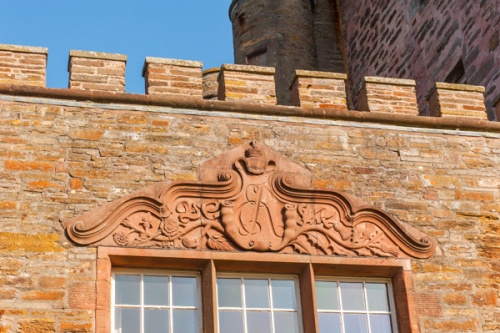
The castle's main entrance had always faced the sea, but Burn and the Earl had other ideas; Burn created a new projecting gatehouse on the landward side, and added a grand dining room. The transformations wrought by Burns created the romantic, turreted castle we see today; a mix of late medieval and Victorian fantasy.
When the 15th Earl died without an heir he left the castle to his friend, FG Heathcote, on condition that Heathcote change his name to Sinclair. This he did, but when Heathcote/Sinclair died, his widow sold the castle to Captain FB Imbert-Terry.
Then in 1952 Queen Elizabeth, The Queen Mother purchased Mey as a place to retreat from the public eye after the death of her husband, King George VI. At that time it was known as Barrogill Castle, but the Queen Mother restored the original name 'Castle of Mey'.
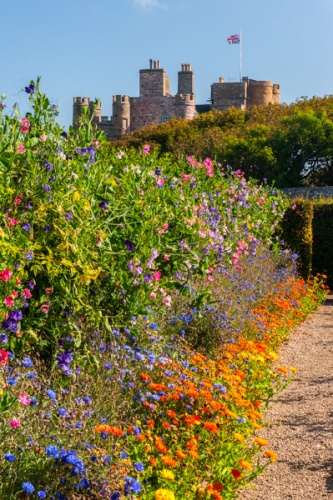
Over the next few decades, she spent three weeks at Mey each August, and 10 days in October. The castle was in poor condition, but over the next few years it was restored to provide a suitable residence, and the Queen Mother turned her attention to the 30 acres of gardens and grounds surrounding the house. Most of the restoration was done by 1955.
The castle interiors are essentially as the Queen Mother left them, with very few exceptions. The very knowledgeable room guides pointed out the new carpet on the entrance stairs; added by Prince Charles. But aside from little touches like that, if the Queen Mother was to walk back into the Castle of Mey today she would instantly recognise every room, every arrangement of furniture, and all the objects on display.
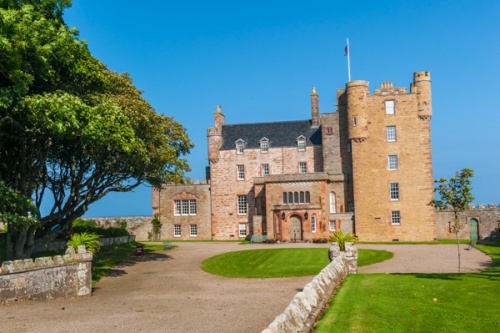
Visiting
Despite the long history of the Sinclair castle, when you visit Mey you are really seeing the castle as it was during the Queen Mother's long stay here. Rooms are displayed as they were in her lifetime, with family photos and mementoes on display.
There are little touches that act as a reminder of her presence, like footstools in front of the Queen Mum's favourite chairs, and bottles of her favourite tipple on a sideboard (gin and Dubonnet, not gin and tonic, as a friendly guide was swift to tell us).
You proceed through the castle at your own pace, with room stewards in many of the major rooms, and extremely good information sheets in each room to show how it was used and to explain several of the most interesting objects on display. The most interesting room was the dining room, where a steward explained the often peculiar meal rituals followed at Mey.
One of these rituals was that when dinner was finished, the ladies would retire to the withdrawing room next door, while the men had port and cigars. Nothing unusual in that, but when the Queen Mother considered that the men had had long enough, the ladies would break into a song, thus letting the men know it was time to drink up and reappear.
Beside the castle is the walled garden, and further afield, the East Garden and woodland. When the Queen Mother purchased the Castle of Mey in 1952 the gardens were in poor condition, but over the following decades, they have been brought back to life.
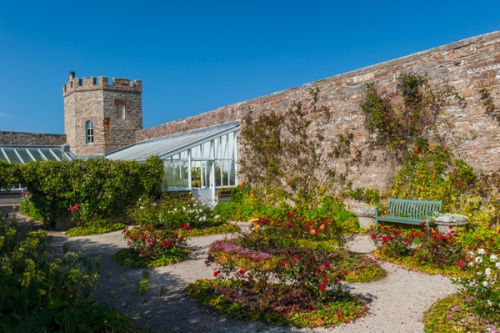
The walled garden, in particular, is a delight, divided into sections by hedges that also create a windbreak, and bursting with colour. Though much of the garden is given over to flowering shrubs and plants, there are protected kitchen gardens and a greenhouse which provide tasty treats for the castle restaurant. One of the most sheltered areas is the Shell Garden, where the Queen Mother would relax with her corgis, and breathe in the scent of old roses.
A short walk towards the shore from the castle brings you to a small agricultural area, with animals on show. Beside this is an exhibition centre, with changing displays of local interest. When I visited they had a display honouring local men and women who fought and, in some cases, died, in World War One.
I loved visiting the castle; the location is magnificent, and the guides really made the life of the Queen Mother at Mey really come alive. The gardens were a delight in late September, full of colour and providing a wonderful backdrop for the historic castle.
About Castle of Mey
Address: Thurso,
Caithness,
Scotland, KW14 8XH
Attraction Type: Castle
Location: 15 miles east of Thurso on the A836.
Website: Castle of Mey
Location
map
OS: ND289 728
Photo Credit: David Ross and Britain Express
HERITAGE
 We've 'tagged' this attraction information to help you find related historic attractions and learn more about major time periods mentioned.
We've 'tagged' this attraction information to help you find related historic attractions and learn more about major time periods mentioned.
Historic Time Periods:
Find other attractions tagged with:
16th century (Time Period) - castle (Architecture) - George VI (Person) - Medieval (Time Period) - Queen Elizabeth (Person) - Restoration (Historical Reference) - Victorian (Time Period) -
NEARBY HISTORIC ATTRACTIONS
Heritage Rated from 1- 5 (low to exceptional) on historic interest
Mary Ann's Cottage - 4.9 miles (Museum) ![]()
Duncansby Head Lighthouse and Sea Stacks - 7.2 miles (Countryside) ![]()
Caithness Broch Centre - 7.3 miles (Museum) ![]()
Nybster Broch - 7.9 miles (Prehistoric Site) ![]()
Keiss Castle - 8.1 miles (Castle) ![]()
Castle Lodge - 10.5 miles (Historic Building) ![]()
Thurso, Old St Peter's Church - 10.7 miles (Historic Church) ![]()
Caithness Horizons Museum & Art Gallery - 10.8 miles (Museum) ![]()
Nearest Holiday Cottages to Castle of Mey:
Nearby accommodation is calculated 'as the crow flies' from Castle of Mey. 'Nearest' may involve a long drive up and down glens or, if you are near the coast, may include a ferry ride! Please check the property map to make sure the location is right for you.
John o Groats, Highlands and Islands
Sleeps: 12
Stay from: £1842 - 7003
More self catering near Castle of Mey
